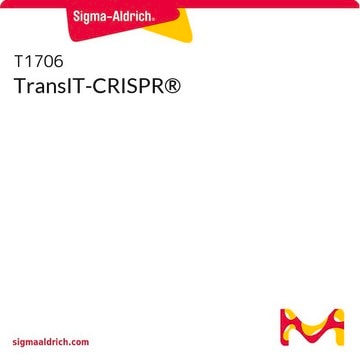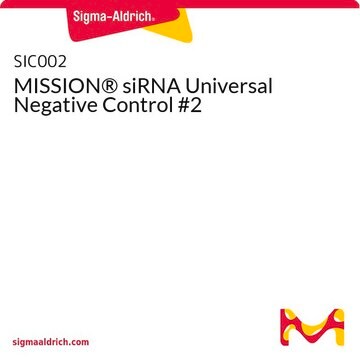SITRAN-RO
Roche
X-tremeGENE™ siRNA Transfection Reagent
Polymer reagent for delivering siRNA to common cell lines
About This Item
Prodotti consigliati
Grado
for molecular biology
Livello qualitativo
impiego
sufficient for 2,000 transfections (04476115001)
sufficient for 400 transfections (04476093001)
Confezionamento
pkg of 1 mL (04476093001 [1 mg/ml])
pkg of 5 × 1 mL (04476115001 [5 x 1 mg/ml])
Produttore/marchio commerciale
Roche
Concentrazione
1 mg/mL
tecniche
transfection: suitable
Condizioni di spedizione
wet ice
Temperatura di conservazione
2-8°C
Categorie correlate
Descrizione generale
This innovative reagent forms a complex with siRNA, as well as with mixtures of siRNA and plasmid DNA (cotransfection), and efficiently delivers the nucleic acids into animal cells to induce gene silencing. Transfection is achieved in just a few steps: mix and incubate diluted transfection reagent with diluted siRNA, then add this complex to cells. Because X-tremeGENE siRNA Transfection Reagent functions exceptionally well in the presence or absence of serum and demonstrates low cytotoxicity, it can be used without media changes. The product is animal-component free.
Contents
Solution filtered through 0.2 μm pore size membrane, supplied in polypropylene tubes.
Applicazioni
Caratteristiche e vantaggi
- Knock down gene expression over 90% in many different cell types.
- Maximize experimental flexibility with a single reagent for siRNA- and cotransfection-based gene-knockdown experiments.
- Produce meaningful results using a reagent that exhibits low cytotoxicity, ensuring that the cellular effects you observe are due to the transfected siRNA rather than the transfection procedure.
- Work with or without serum, avoiding medium changes (e.g., to serum-free medium) before or after transfection.;
X-tremeGENE siRNA Transfection Reagent is a proprietary blend of lipids and other components, free of animal products.
Qualità
Cytotoxicity analysis: HEK-293 cells are exposed to siRNA/X-tremeGENE siRNA Reagent complexes for 72 hours in the presence of serum, without a media change. Cytotoxicity is then tested by analyzing the cells with the WST-1 Cell Proliferation Reagent (Roche).
Altre note
Note legali
Prodotti correlati
Codice della classe di stoccaggio
12 - Non Combustible Liquids
Classe di pericolosità dell'acqua (WGK)
nwg
Punto d’infiammabilità (°F)
does not flash
Punto d’infiammabilità (°C)
does not flash
Certificati d'analisi (COA)
Cerca il Certificati d'analisi (COA) digitando il numero di lotto/batch corrispondente. I numeri di lotto o di batch sono stampati sull'etichetta dei prodotti dopo la parola ‘Lotto’ o ‘Batch’.
Possiedi già questo prodotto?
I documenti relativi ai prodotti acquistati recentemente sono disponibili nell’Archivio dei documenti.
I clienti hanno visto anche
Articoli
Small inhibitory RNAs offer easy gene expression knockdown in mammalian cells, revolutionizing gene research.
Transfection introduces genetic material into cells, aiding research in gene expression and cell biology.
This brief webinar provides an overview of what transfection is and the methods that are used to introduce DNA or RNA into eukaryotic cells.
Genetic engineering enables large-scale expression and isolation of recombinant proteins for research purposes.
Protocolli
X-tremeGENE™ siRNA Transfection Reagent Protocol & Troubleshooting
Protocols for Transfecting Common Cell Lines with X-tremeGENE™ Transfection Reagents
Contenuto correlato
Browse our convenient transfection reagent selection guide to match the best reagent for your specific cell line and application needs.
Il team dei nostri ricercatori vanta grande esperienza in tutte le aree della ricerca quali Life Science, scienza dei materiali, sintesi chimica, cromatografia, discipline analitiche, ecc..
Contatta l'Assistenza Tecnica.















